Key takeaways:
- Hybrid publishing combines traditional and self-publishing, allowing authors to maintain creative control while receiving professional support.
- Key advantages include higher royalties, personalized publishing experiences, and access to expert marketing services.
- Challenges may involve hidden fees, variable service quality, and ongoing marketing responsibilities for authors.
- Future trends suggest an integration of technology, sustainability in practices, and the rise of community-driven publishing networks.
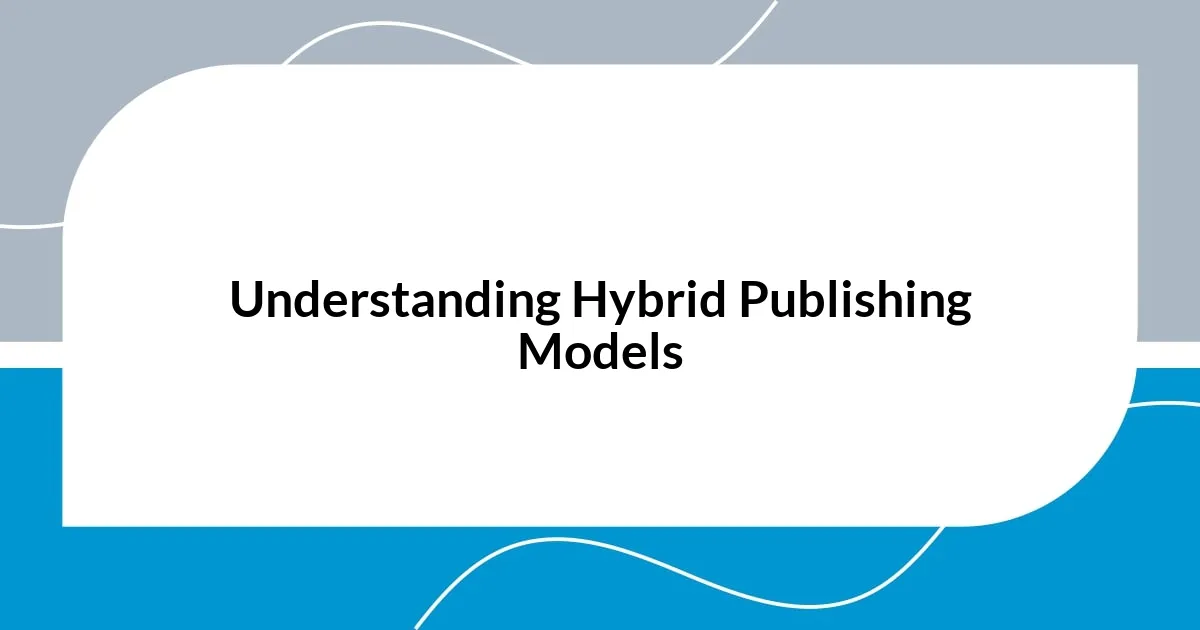
Understanding Hybrid Publishing Models
Hybrid publishing models represent a fascinating intersection between traditional and self-publishing. Unlike the purely traditional route, hybrid publishing allows authors to retain more control over their work while still benefiting from professional services. I’ve always been intrigued by this balance—how great would it feel to partner with an established publisher but still maintain a sense of ownership over your writing?
Thinking back, I remember chatting with a friend who self-published her book. While she was excited about the freedom, she also struggled with marketing it alone. Hybrid publishing could have offered her that sweet spot—professional support in distribution and promotion while still having her voice shine through. Have you ever found yourself torn between wanting creative control and seeking industry expertise? That’s where hybrid publishing models come into play.
These models can also vary greatly in how they function. Some may charge upfront fees while others take a percentage of sales. Personally, I think this flexibility can cater to different authors’ needs, but it’s crucial to thoroughly research and choose a reputable hybrid publisher. It’s all about finding what feels right for your journey as a writer.
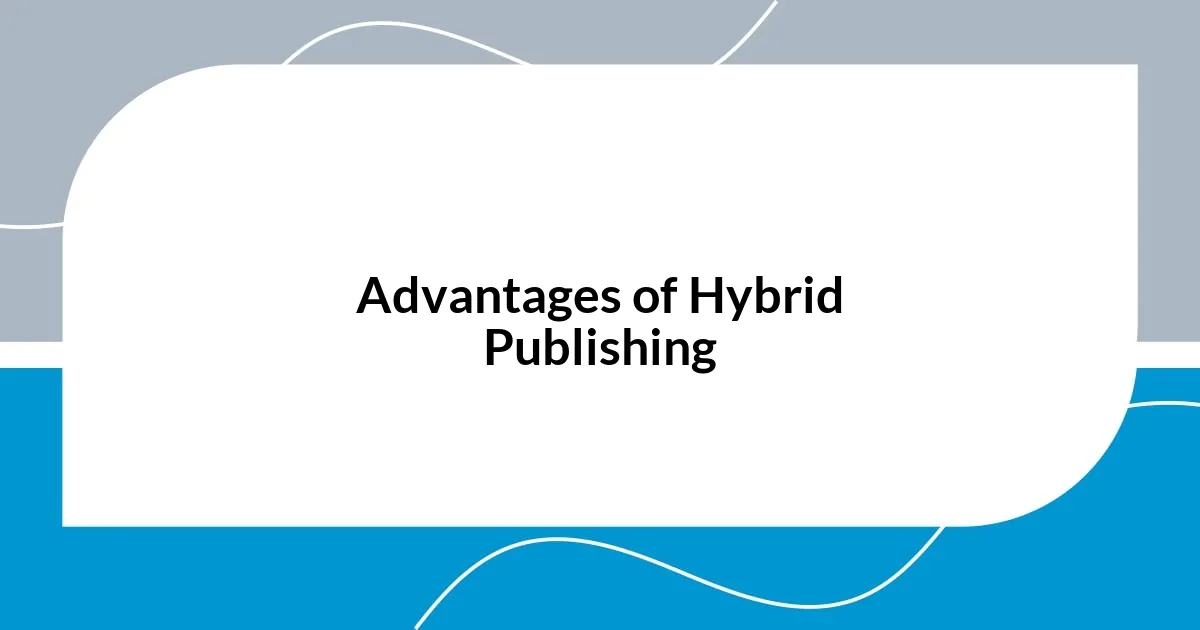
Advantages of Hybrid Publishing
Hybrid publishing models offer a blend of control and professional support that can be incredibly empowering for authors. Having worked with both traditional and self-publishing approaches, I’ve found that the ability to make key decisions while still accessing expert guidance feels like the best of both worlds. It’s like having a safety net while you’re on a tightrope, and that reassurance can lead to a more confident creative process.
What truly excites me about hybrid publishing is its adaptability. For example, I recently attended a workshop where a hybrid publisher shared success stories of authors who thrived in this environment. Many of them highlighted how they could customize their publishing experience to fit their unique vision, whether it was choosing their book cover design or deciding on promotional strategies. That kind of personalized approach really appeals to today’s authors who want a partnership rather than a one-size-fits-all solution.
Moreover, hybrid publishing can often result in better royalties. From my own experience, I’ve seen authors who have managed to negotiate favorable deals that allow them to keep a larger portion of their earnings compared to traditional publishing. This financial aspect makes a significant difference, especially for those of us who want our hard work to be rewarded fairly. Have you thought about how much royalties matter to you as an author? It’s certainly a topic that deserves attention.
| Advantages of Hybrid Publishing | Description |
|---|---|
| Control | Authors retain ownership and creative rights over their work. |
| Professional Support | Access to editing, design, and marketing services helps increase the book’s quality and visibility. |
| Higher Royalties | Authors often earn a larger percentage of sales compared to traditional publishing models. |
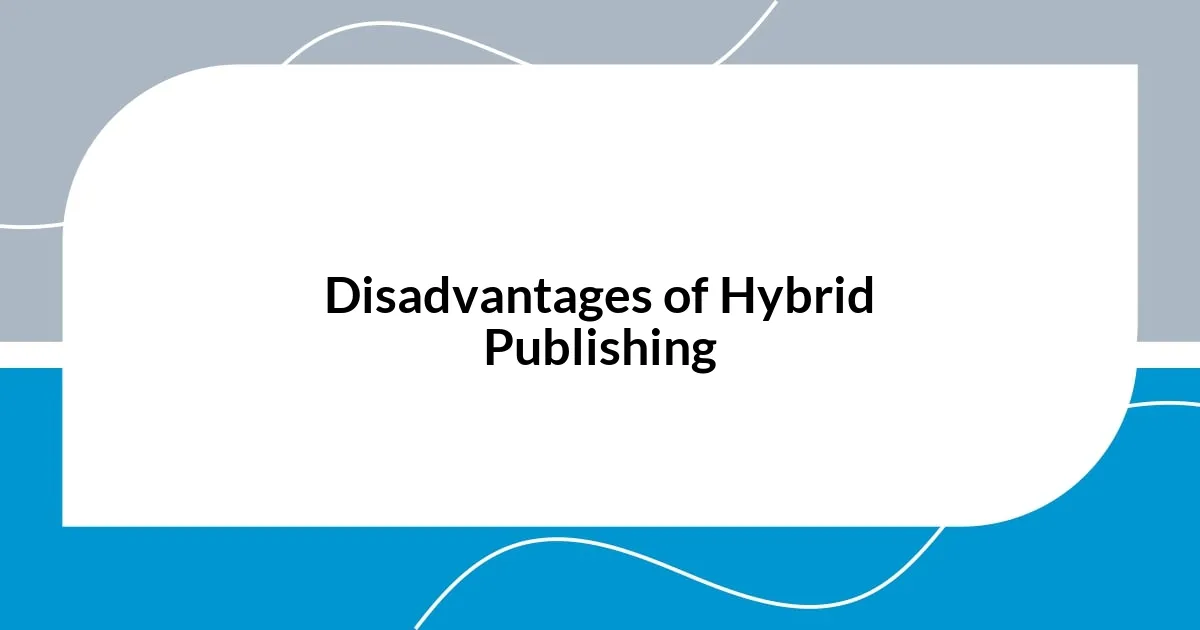
Disadvantages of Hybrid Publishing
The disadvantages of hybrid publishing can sometimes overshadow its benefits. I recall talking to an author friend who jumped into a hybrid model, hoping for an ideal balance of support and freedom. Unfortunately, she quickly discovered that some hybrid publishers have hidden fees that weren’t upfront, cutting into her potential profits and leaving her feeling frustrated. It made me realize that transparency is crucial in this space.
Here are some pitfalls to consider:
- High Costs: Upfront fees or service costs can add up quickly, making it more expensive than anticipated.
- Quality Variability: The quality of services can differ significantly between hybrid publishers, leading to mixed results.
- Lack of Market Reach: Some hybrid publishers may not have strong distribution networks, limiting the book’s visibility.
- Marketing Burden on Authors: Even with support, authors may still bear a substantial load in terms of marketing and promotion, which can be exhausting.
These factors made me think deeply about the balance between investment and return. I believe it’s essential for authors to weigh these disadvantages carefully against their own goals and resources. There’s no one-size-fits-all solution, and what works for one author might not suit another at all.
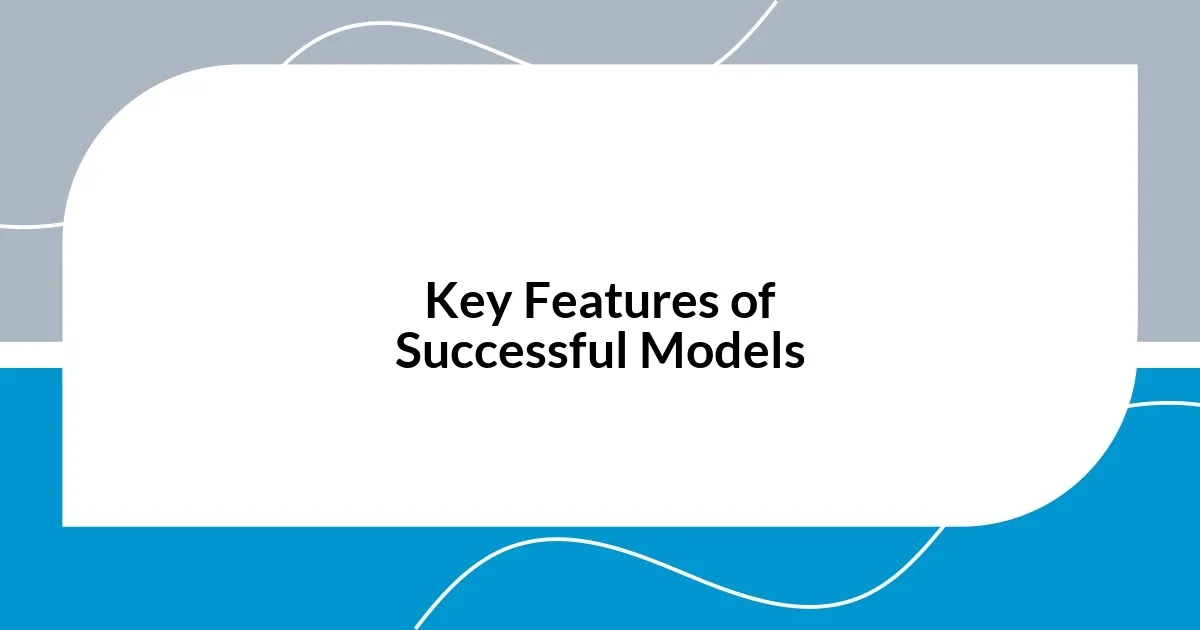
Key Features of Successful Models
A successful hybrid publishing model often showcases a strong partnership between authors and publishers. In my experience, when both parties share a clear vision, it leads to a more cohesive and effective publishing journey. It’s like collaborating on a masterpiece—each contribution amplifies the final product, and that synergy can turn a good book into a great one.
Another key feature is transparent communication about financial aspects. I once worked with a hybrid publisher who took the time to explain every fee and potential return on investment. That clarity not only built trust but also empowered me to make informed decisions that directly impacted my book’s success. Have you ever felt lost in the fine print of a contract? Knowing exactly where your money goes makes a world of difference.
Finally, adaptability remains essential for thriving in this space. I recall a project where the author shifted gears midway through the process, wanting to target a different audience. The hybrid model allowed for this pivot with minimal fuss, showcasing how flexibility can impact overall outcomes. Isn’t it great to think about how being nimble and responsive can keep your publishing journey aligned with your goals? That’s what I appreciate most about successful hybrid publishers—they can evolve alongside their authors.
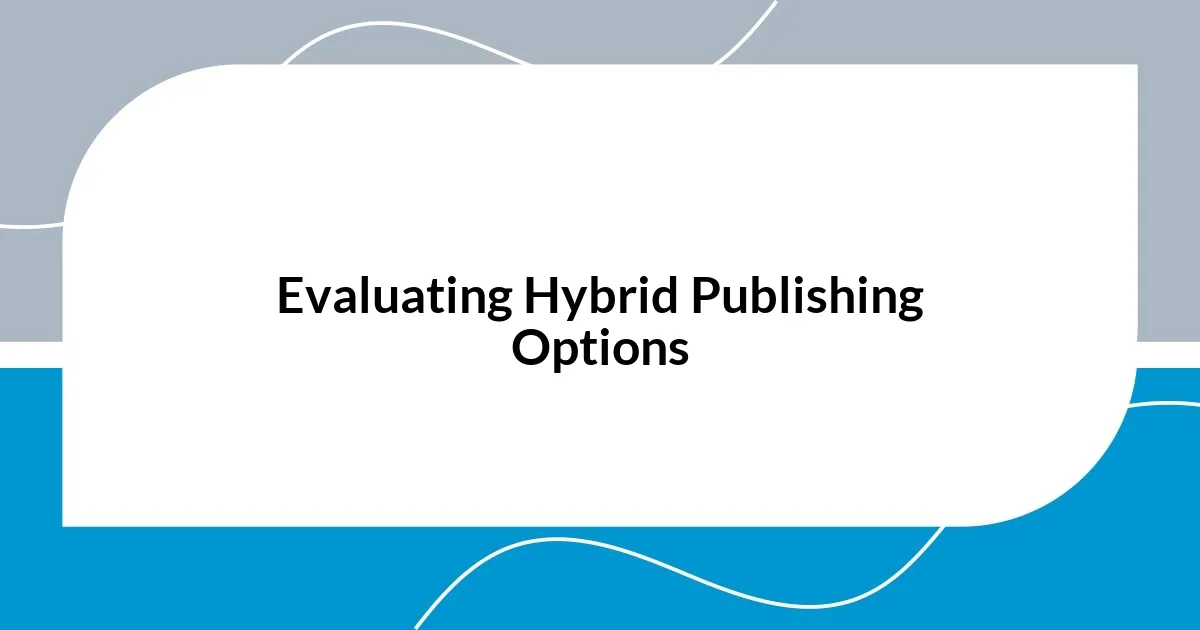
Evaluating Hybrid Publishing Options
When considering hybrid publishing options, evaluating the services offered is key. I remember a time when I had multiple publishers reach out, each claiming the best services available. My gut instinct told me to dig deeper. What I found was that not all of them delivered on their promises—some had great marketing plans on paper, but their execution left much to be desired. Have you ever found yourself caught in the gap between expectation and reality? It’s crucial to examine each option thoroughly.
Another aspect to consider is the level of control you want over your publishing process. I once engaged with a hybrid publisher that allowed me significant input in design and marketing strategies, which was empowering. This level of autonomy is vital for authors who want to preserve their voice and artistic vision. However, others might prefer a more hands-off approach. Which one resonates with you more? Knowing your personal preferences can guide you toward a better fit in this diverse landscape.
Lastly, don’t overlook the importance of publisher reputation and past success stories. I was fortunate enough to speak with authors who had previously worked with a particular hybrid publisher, and their experiences offered invaluable insights. I often ask myself: What do successful authors look for in a partnership? Their shared stories of satisfaction or dissatisfaction can reveal a lot about what you can expect. It’s all about connecting with the right people who truly get your vision and want to help you flourish.
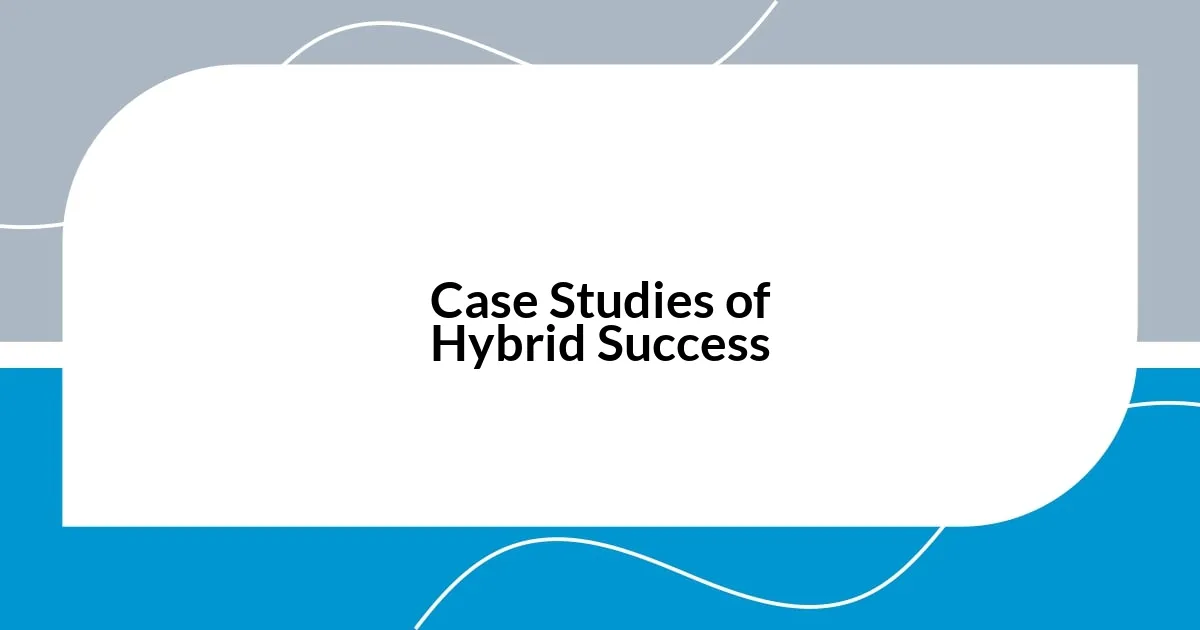
Case Studies of Hybrid Success
One shining example of hybrid publishing success that I often refer to is the journey of an author friend who published a memoir through a hybrid model. She initially faced skepticism about her unconventional narrative, but the hybrid publisher not only embraced her unique voice but also guided her in crafting a powerful marketing strategy. This partnership resulted in her book reaching an audience she never thought possible—an authentic community that resonated deeply with her story. Have you ever experienced a similar boost in confidence when your vision is truly valued?
Another inspiring case that stands out to me involves an academic who wanted to transform her dissertation into a broader audience-friendly book. The hybrid publisher she chose provided an avenue for her to marry scholarly rigor with accessibility, allowing her to retain her credibility while engaging a wider readership. I saw firsthand how the blend of her expertise and the publisher’s marketing brainpower led to significant sales and speaking engagements. Doesn’t it make you think about the endless possibilities when knowledge meets creativity?
Lastly, I can’t help but think about a series of children’s books that truly thrived under a hybrid model. The author, passionate about engaging young readers, was able to collaborate with illustrators and educators to craft a rich, interactive experience. The flexibility of the hybrid approach not only ensured her vision was realized but also led to partnerships with schools and libraries, expanding her reach far beyond what traditional publishing could offer. Isn’t it fascinating how a supportive publishing environment can unlock the full potential of an author’s creativity?
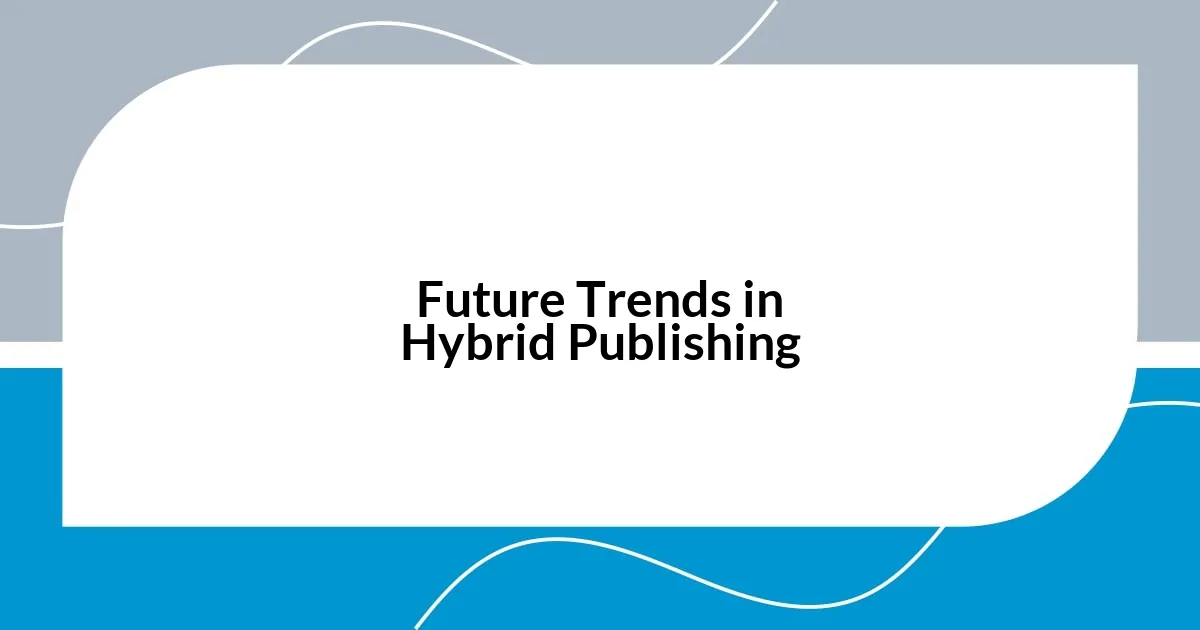
Future Trends in Hybrid Publishing
The landscape of hybrid publishing is set to evolve in exciting ways, and I can’t help but feel enthusiastic about what’s on the horizon. For instance, the integration of advanced technology like AI in marketing strategies is becoming more common. I recall experimenting with AI tools for targeting audiences; the results were fascinating! This trend suggests that authors will gain even more precise insights into their readers, making the publishing process feel almost tailor-made. How might this change the way we connect with our communities?
Another major trend I foresee is the growing emphasis on sustainability in publishing practices. I remember having a conversation with an eco-conscious author who championed environmentally friendly printing. They illustrated how hybrid publishing could lead the charge in adopting greener materials and practices. This shift not only appeals to conscious consumers but also aligns with the values of a new generation of writers and readers alike. Isn’t it refreshing to think that our choices can influence the health of our planet while bringing our stories to life?
Lastly, the rise of community-driven publishing is something I’m genuinely excited about. I had an enlightening experience at a recent author collaborative event where various writers came together to share insights and promote each other’s work. It felt like a vibrant ecosystem buzzing with creativity and support. I envision more hybrid publishers fostering these author networks, allowing voices to amplify each other and creating a sense of belonging. How powerful would it be if we collectively supported one another’s journeys?